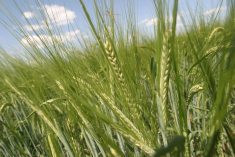New Fhb7 varieties of wheat with better FHB resistance may be available in a few years, developed in North Dakota
Plant geneticists the world around are devoting billions of dollars and centuries of accumulated time trying to breed better fusarium head blight resistance into wheat. Some fail. Some succeed.
One of the most promising endeavours is the discovery and cloning of a gene that has been named Fhb7. The gene reduces FHB by detoxifying mycotoxins secreted by the pathogen. The gene also confers resistance to crown rot, a cereal disease caused by a related pathogen.
Fhb7 fosters resistance to scab in new plants with no reduction in yield or reduction of other positive traits. It opens new avenues into molecular mechanisms that can create resistance to the pathogen in wheat, barley, winter wheat and oats.
Read Also

Growing garlic by the thousands in Manitoba
Grower holds a planting party day every fall as a crowd gathers to help put 28,000 plants, and sometimes more, into theground
One of the leaders on the project is Steven Xu at the U.S. Department of Agriculture’s Agricultural Research Service in Fargo, N.D. Xu projects that new Fhb7 varieties with better FHB resistance may be available in a few years.
“Depending on how fast breeding progresses, I estimate it will be five to seven years before farmers benefit from this breeding,” Xu said in an email.
Geneticists are working as fast as possible, he added, because FHB costs American wheat producers $10 billion a year.
“In the U.S. my lab is working with durum and hard red spring wheat and winter wheat for North Dakota, South Dakota and Minnesota. I have also provided seed of our germplasm to breeders in Washington, New York, Oklahoma, Kansas, Idaho and Australia.”
The researchers first identified the unique gene in thinopyrum wheatgrass, a wild relative of wheat that has been previously used to develop varieties of wheat with beneficial traits such as rust resistance and drought tolerance. They cloned the gene and introduced it into seven wheat cultivars with different genetic profiles to study its effects on plants grown under field conditions. The results showed that the gene not only conferred resistance to FHB in new plants but also had no negative effects on yield or other significant traits.
“The original seven winter wheat cultivars were all highly susceptible to FHB, that’s why we choose them. They become resistant after they acquired Fhb7 by backcross breeding. The seven winter wheat cultivars with added Fhb7 maintained their agronomic characteristics in yield.”
FHB is caused by the fungal pathogen fusarium graminearum. It causes significant losses in the United States, China, Canada, Europe and many other countries. It also attacks barley and oats. When the pathogen grows unchecked in infected grains, it releases mycotoxins that can induce vomiting in humans, as well as weight loss in livestock when they refuse to eat the grains. The prevalence and severity of FHB outbreaks could be exacerbated by climate change and by an increasing trend toward more corn production and no-till farming.
The study was led by scientists at the Shandong Agricultural University in China. Co-authors include ARS researchers in Manhattan, Kansas, and Xu in Fargo.


















